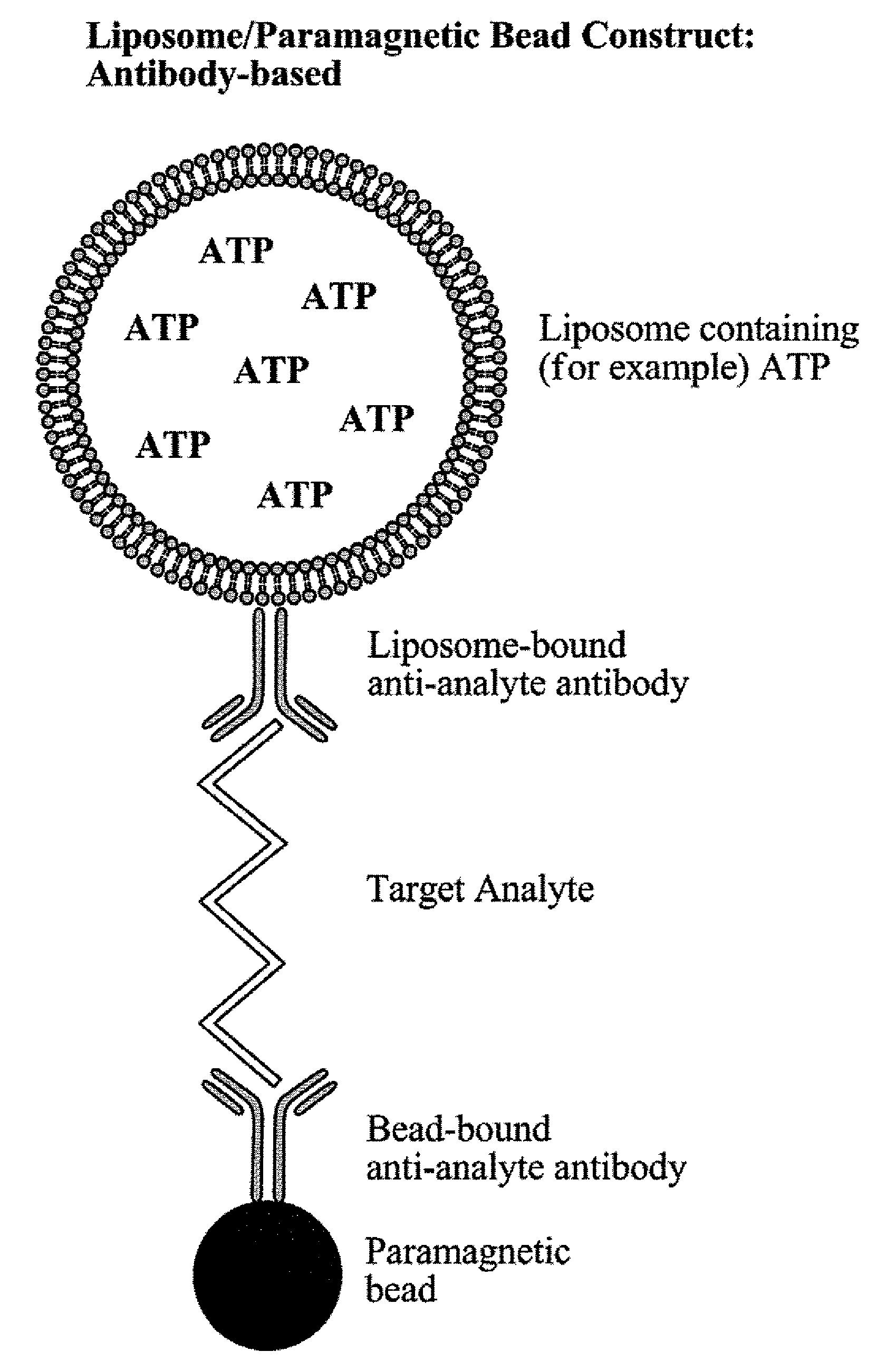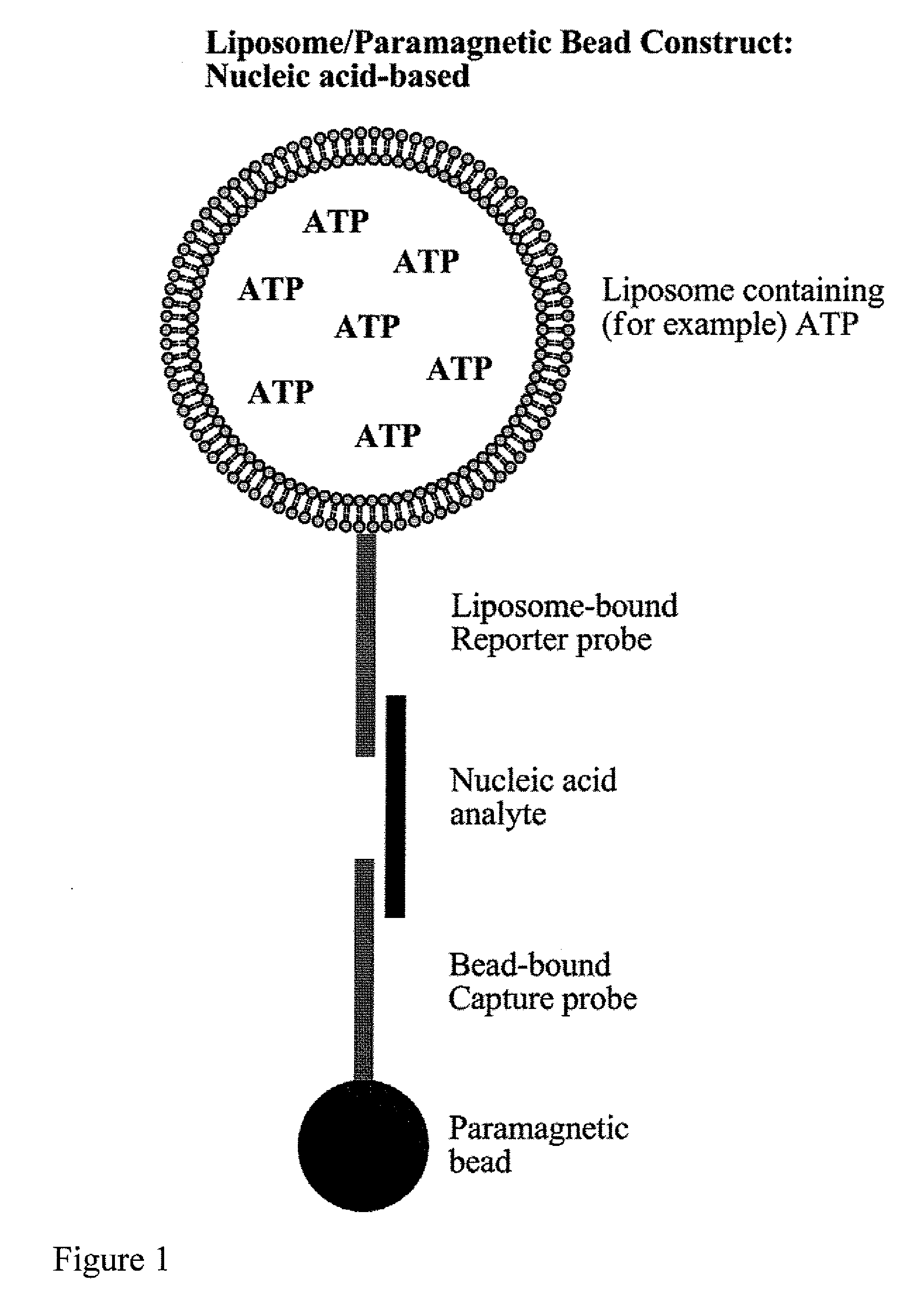Detection of Analytes in Samples Using Liposome-Amplified Luminescence and Magnetic Separation
a technology of luminescence and magnetic separation, applied in the field of assays, can solve the problems of inconvenient detection, low contamination rate, slow growth, etc., and achieve the effect of reducing the cost of conventional bacterial detection and reducing the cost of detection
- Summary
- Abstract
- Description
- Claims
- Application Information
AI Technical Summary
Benefits of technology
Problems solved by technology
Method used
Image
Examples
example 1
Encapsulation of ATP Into Liposomes
[0049]A total of six batches of liposomes were produced, in which ATP was encapsulated at four different concentrations. Liposomes containing 0 mM (one batch); 150 mM (three batches); 300 mM (one batch); and 400 mM (one batch) were prepared. It was found that, at ATP concentrations of 300 mM and 400 mM, significant aggregation of the liposomes occurred. Liposomes carrying 150 mM ATP remained unaggregated, and were suitable for use in the detection assays of the invention.
[0050]Generally, liposomes can be prepared by any method known to one skilled in the art. Several methods for encapsulating ATP and other luminescence-related amplificants are known. For example, Guo-Xing described and evaluated four methods for the encapsulation of ATP. (Guo-Xing et al, Adenosine Triphosphate Liposomes: Encapsulation and Distribution Studies, 7(5) Pharm. Res. 553-557 (1990)). Specifically, Guo-Xing described thin film-formed vesicles, reverse-phase evaporation ves...
example 2
Performance of ATP-Encapsulated Liposomes
[0057]Liposomes encapsulating 150 mM ATP were used for this example. In order to estimate the potential improvement in assay sensitivity possible by encapsulation of ATP, we compared the ability to detect liposomes encapsulating either 150 mM ATP, a bioluminescence-related amplificant, or 150 mM sulforhodamine B (SRB), fluorescence-related amplificant. Each set of liposomes was subjected to serial 10-fold dilutions and analyzed by using the assay shown in Table II to determine which population of liposomes could be detected at the highest possible dilution.
[0058]Both sets of liposomes were treated with either 60 mM n-octylglucopyranoside (OG, ‘Extractant 1’) or ‘Extractant 2’ in order to release the amplificant from the liposomes. It was found that the SRB-encapsulated liposomes could be detected at dilutions of 1 / 100,000 whether intact, or disrupted via Extractant 1 or Extractant 2 (Table III). The ATP-encapsulated liposomes, on the other ha...
example 3
Demonstration of Further Improvement in Performance Through the Use of Paramagnetic Beads
Immobilization of Oligonucleotides on Paramagnetic Bead Surface.
[0062]Biotinylated capture oligonucleotide probes were conjugated by methods known to those skilled in the art to streptavidin coated paramagnetic beads. After conjugation and washing, the labeled paramagnetic beads were stored at 4° C. for several months. It was noted that, while this particular example relates to the immobilization of oligonucleotides, antibodies or other compounds capable of binding to a sample can be also be used.
Determination of Detection Limits
[0063]The limits of detection of the assay system of the present invention were determined using a synthetic nucleotide sequence. A sandwich hybridization assay was performed in microplate wells using 15 μl of a 1:10 dilution of liposomes and 5 μl (1.25 μg) of paramagnetic beads. The bead-target-liposome complex was washed using two types of magnetic devices to retain th...
PUM
| Property | Measurement | Unit |
|---|---|---|
| diameter | aaaaa | aaaaa |
| diameter | aaaaa | aaaaa |
| diameter | aaaaa | aaaaa |
Abstract
Description
Claims
Application Information
 Login to View More
Login to View More - R&D
- Intellectual Property
- Life Sciences
- Materials
- Tech Scout
- Unparalleled Data Quality
- Higher Quality Content
- 60% Fewer Hallucinations
Browse by: Latest US Patents, China's latest patents, Technical Efficacy Thesaurus, Application Domain, Technology Topic, Popular Technical Reports.
© 2025 PatSnap. All rights reserved.Legal|Privacy policy|Modern Slavery Act Transparency Statement|Sitemap|About US| Contact US: help@patsnap.com



